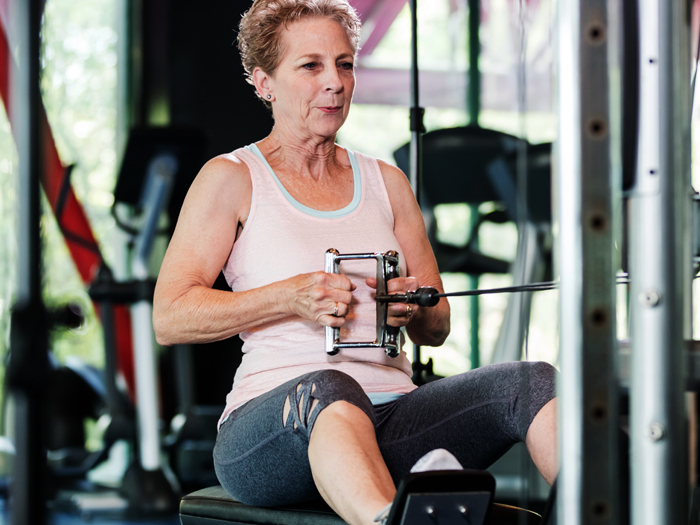5 Amazing Things That Happen to Your Body When You Start Lifting Weights
Even if building muscle isn’t your main focus, strength training can help you hit your health and wellness goals.

Why do most people start lifting weights?
- Build muscle
- Lose fat
- Feel more capable and confident on their feet to stay independent longer
- Help boost brain power, protect their heart, and fight cancer
Chances are you did not pick the last one.
When most people start lifting weights, they’re thinking about building strength and burning fat—even though the benefits of pumping iron go far beyond flexing.
“Strength training works literally every part of your body, from your musculoskeletal system and brain to your cardiovascular system and hormonal health,” says Matt Kite, C.S.C.S., director of education at D1 Sports Training. “Seriously, no cell is left unturned.”
With at least two to three strength sessions per week, that translates into some amazing health benefits—beyond building muscle. Here are five results of regular weight lifting that are often overlooked, plus tips on how to maximize each.
1. Your Brain and Mood Get an Instant Boost
Strength training is just as much mental as it is physical. With each workout session, your brain floods with neurochemicals that influence both your cognition and mood.
More specifically, feel-good endorphins and dopamine in the brain promote stress relief and have an anti-anxiety effect. And brain-derived neurotrophic factor encourages the growth of new brain cells and helps protect existing ones.
That’s good news for your brain at any age, but lifting weights may be especially effective for older adults.
A 2016 study in the Journal of the American Geriatrics Society found adults ages 55 to 86 with mild cognitive impairment who did strength training two to three times per week for six months improved their cognitive test scores.
“Muscle contractions needed for strength training start with the excitability of the brain,” Kite says. “The more you train, the more efficiently your brain can fire.”
For best cognitive benefits, the key may be to push yourself within what’s safe for you. Working at a higher intensity—compared to absentmindedly curling dumbbells—increases the flow of blood, oxygen, and nutrients to the brain, which may explain the improvement in cognitive test scores, Kite says.
2. You Safeguard Your Heart
Cardio gets all the credit for boosting, well, cardio health. But recent research found strength training may be more strongly associated with reducing risk of cardiovascular disease than activities like walking and biking.
Meanwhile, other research in the Journal of Applied Physiology found HDL, or good, cholesterol functions better in men who strength train than those who don’t.
Experts are still investigating exactly why this happens, but one possible explanation is that strength training increases blood flow to working muscles more than aerobic exercise does.
The two most important factors for getting your heart rate up and blood pumping during strength training are:
- The number of muscles any given exercise works
- The intensity at which you perform that exercise
For both, more is generally better. Choose multi-joint, compound exercises, such as pushups, squats, and stepups, and perform them to fatigue—meaning you do as many reps as you can with proper form before stopping. As soon as your form starts breaking down, that’s a sign you’ve done enough.
Want more guidance? Try this 30-minute total-body strength workout. It’s made up of just five compound movements that each recruit multiple muscle groups at the same time.
3. You Fry Fat and Improve Metabolism
Any exercise burns calories, but strength training goes one step further by increasing basal metabolic rate, or the number of calories you burn just to live and breathe.
That’s because lean muscle mass, which weight lifting builds, is the single greatest factor in setting metabolic rate, Kite says. “Higher levels of lean body tissue lead to higher metabolism levels and increased efficiency of burning calories.”
Lean muscle mass also functions as a “glucose sink,” meaning it uses a huge amount of the glucose, or sugar, coursing through your blood. Research has found strength training not only increases lean muscle—it also improves how well your muscles can take in glucose.
For the greatest metabolic benefit, the advice is the same as before: Prioritize compound movements that work multiple muscle groups, such as pushups, squats, and stepups, over isolation exercises, like biceps curls or calf raises.
4. You Move Easier—Free of Aches, Pains, and Injury
Strength training doesn’t just help muscles. It strengthens your entire musculoskeletal system, including bones, ligaments, tendons, and other connective tissues, says James Lee, D.P.T., a physical therapist at the Hospital for Special Surgery in New York City.
Strength training is a prime example of what experts call weight-bearing exercise, meaning anything you do on your feet with your bones supporting your weight. Over time, this downward force of weight on your bones helps increase bone mineral density and strength, Kite says.
Regular weight-bearing exercise is essential for the prevention of osteoporosis, which makes bones brittle. And for people with osteoporosis, it’s important to do as much weight-bearing exercise as one can safely tolerate.
Subscribe to our newsletter
It's quick and easy. You could be one of the 13 million people who are eligible.
Already a member? Click to discover our 15,000+ participating locations.
Follow Us
Stronger bones aside, lifting weights also promotes joint function and muscle flexibility to boost mobility and reduce risk of injury, Lee says. In other words, you’ll move more easily and safely.
Your body moves by a use-it-or-lose-it principle. To maintain mobility for decades to come, focus on moving through a full range of motion during weight training, meaning you don’t cut any exercises short, Lee says.
Not sure what a full range of motion means for you? Try performing several reps of an exercise with a light weight or no weight at all. Pay attention to how far each joint can comfortably move while allowing you to maintain proper form. As soon as your form starts to break down, you’ve gone too far.
Watch yourself in a mirror, take a video on your phone, or ask a trainer at your local gym to observe your body positioning. And keep in mind the more you exercise, the more range of motion you’ll have available over time.
5. You Can Fight Cancer Head On
Observational research of more than 80,000 adults found people who strength train regularly are 31 percent less likely to die from cancer, compared with those who don’t lift regularly.
Any type of exercise can help reduce cancer risk, Kite says, but strength training has an edge by also improving the body’s ability to survive cancer treatment.
Muscle mass is a strong predictor of how well people can tolerate the side effects of harsh cancer treatments like chemotherapy, according to a review in Therapeutic Advances in Medical Oncology. And low muscle mass may be startlingly common, scientists are discovering. In fact, a JAMA Oncology study found 34 percent of women who were newly diagnosed with nonmetastic breast cancer had low muscle mass.
By adding two to three strength sessions to your weekly routine now, you’ll increase muscle mass and better prepare your body to handle whatever life throws your way.
Ready to help your brain, heart, metabolism, joints, and whole body? Here’s the perfect place to start: our guide to everything you need to know about strength training.
Check Your SilverSneakers Eligibility Instantly
SilverSneakers members can go to thousands of gyms and fitness locations across the nation, plus take exercise classes designed for seniors and led by supportive instructors. If you have a Medicare Plan, it may include SilverSneakers—at no additional cost. Check your eligibility instantly here.
Already a member? Get your SilverSneakers member ID and exclusive fitness content by logging in to or creating your online account here.



